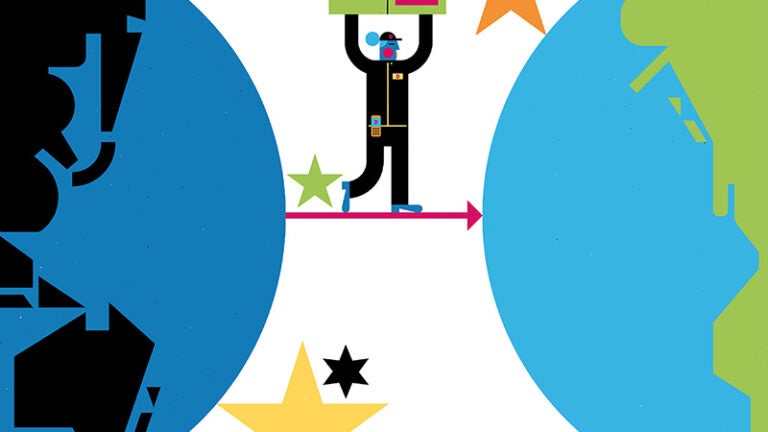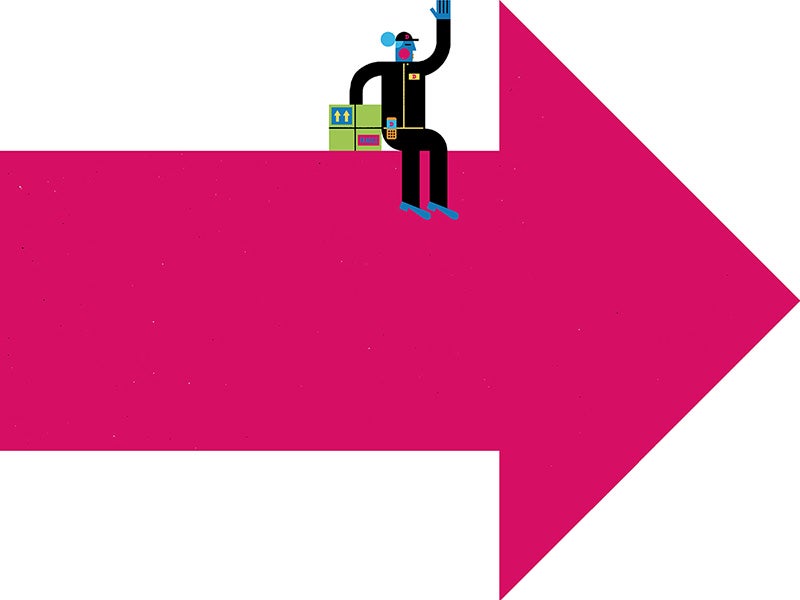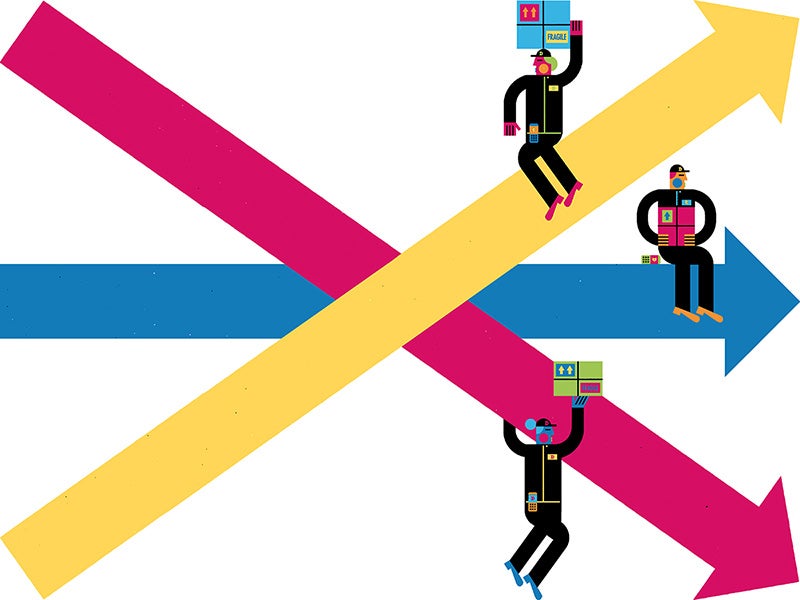
Many companies seek cheaper manufacturers, even if they are thousands of miles away from end users. (Illustration/Raymond Biesinger)
The U.S.’s Supply Chain was a Ticking Time Bomb. Here’s How to Rebuild It
COVID-19 revealed the fragility of our complex supply chain logistics. Expert Nick Vyas believes we can make it strong, green and pandemic proof.
Nick Vyas settles into his office chair in front of his computer for a Zoom meeting. One by one, dozens of Los Angeles-area sixth graders populate the screen.
Vyas can’t remember the last time he faced such youthful students. As an associate professor of clinical data sciences and operations at the USC Marshall School of Business, the supply chain expert is used to talking about logistics in front of college classes.
But this precocious group of middle schoolers wastes no time telling Vyas about how supply chain issues jolt their daily lives. Their school uniforms are on backorder, they say. They see sparse grocery store shelves. And they want to know why.
“Why don’t we make more stuff here?”
“Why is it taking so long to get the game I ordered?”
“When will things get back to normal?”
Before COVID-19 derailed daily life and threw the global supply chain into disarray, Vyas says few adults — let alone tweens — concerned themselves with the complex labyrinth that keeps us stocked with the products we want, when we want them. But supply chain issues in 2021 make the once-wonky subject a hot topic, even among school kids who would never have been interested in it a few years ago.
And it’s a part of the global economy that’s desperately seeking stability.
That reality makes Vyas, who helped launch the USC Marshall Center for Global Supply Chain Management a decade ago, a sought-after expert among everyone from corporate leaders to national media. And a recent $20 million gift from USC alum Randall R. Kendrick promises to advance USC’s prominent role in supply chain education, research and thought leadership even further at a time when applied research, data science and objective scrutiny are critically important.
Between media interviews and guest talks, Vyas recently talked with USC Trojan Family Magazine about supply chain logistics. From backordered bicycles to the skyrocketing cost of lumber, COVID-19’s far-reaching impact on our goods in 2021 may have exposed the inevitable. Now what?

How a “Cheaper, Better, Faster” Philosophy Drove Supply Chain Management
According to Vyas, two critical things happened that shaped the world’s current supply chain: First, China opened its economy and became the world’s dominant manufacturing hub. At the peak of its manufacturing prowess, China fulfilled more than 40% of global demand for a wide variety of consumables.
At the peak of its manufacturing prowess, China fulfilled more than 40% of global demand for a wide variety of consumables.
Second, a cheaper, better, faster mindset took hold, trumping any widespread appetite — and motivation — to invest the time and money for a more stable, sustainable supply chain. Focusing on goods that were cheapest to make often meant favoring economics over the environment, capitalism over conscience and an all-out-rush for efficiencies over social equity and worker well-being.
Few considered the risks of that incessant push, especially as the economy sprinted along with satisfied consumers and profitable enterprises. Its weak spots, however, lingered above the world like clouds on an overcast day. As industries relied on a few key manufacturing hubs instead of diversifying, the supply chain became less nimble and resilient. Companies sought cheaper manufacturers even if they were thousands of miles away from end consumers. Many retailers kept overhead low with fewer products in stock, assuming that they would always be able to order inventory as needed.
“This was a time bomb waiting to explode,” Vyas says.
COVID-19 Exposed Weak Links in Global Supply Chain Management
Our supply chain is a complex web spanning every corner of the world. But throw in a global pandemic and the fast-moving, highly orchestrated global network began to fray.
Anything and everything subject to disruption, from raw materials to last-mile delivery, has been affected.
Nick Vyas
COVID-19 brought supplier operations to an abrupt halt in more than 160 countries. Initially, coronavirus outbreaks and stay-at-home orders forced workers to quarantine at home. As factories went dark, production stalled. The ensuing backups would later clog major North American ports and overwhelm the distribution industry as they tried to dig out of the backlog. Consumers quickly felt the impact. We saw slimmer menus and higher prices at our favorite restaurants. Fewer products ended up on store shelves and heftier price tags appeared on items ranging from diapers to lumber as demand — and some panic buying — overran availability and supply. Customers saw lengthy backorder times on bikes, furniture and more.
And we can’t rely on a proverbial “flip of a switch” to get things moving again, Vyas says. “Anything and everything subject to disruption, from raw materials to last-mile delivery, has been affected,” he says.
Businesses and consumers were already stressed with the pandemic’s unrelenting grip on American life as it upended school, work and family. Supply chain troubles on top of everything else became another reminder of our unpreparedness for a global crisis.

The Pandemic Complicates Our Approach to Supply Chain Management
Many companies responded to supply chain disruptions by switching to “just in case” inventory, purchasing more goods to have them on hand. But that strategy will dissipate, Vyas says, as the underlying problem — a lack of supply chain resiliency — persists.
Meanwhile, consumer demand endured, even increasing in some cases. This placed added pressure on supply chains and further escalated costs as many U.S. consumers and others in Western democracies continued injecting money into the system to maintain their lifestyles.
The average new car price soared 12% and hit a record high of $38,255, according to J.D. Power.
Prices for food eaten away from home increased 4% from May 2020 to May 2021, according to the Bureau of Labor Statistics. In that same period, the average new car price soared 12% and hit a record high of $38,255, according to J.D. Power.
With COVID-19’s continued presence breeding financial uncertainty — “remember, the market doesn’t like uncertainty,” Vyas says — the uneasy marriage between supply and demand signals continued tension for the near future.
“It’s like a spring that oscillates for a long time before it balances itself out and returns to stability,” he says. “That’s where we’re at right now. We’re the spring that’s still vacillating.”
In other words, the pandemic isn’t over — and neither are our supply chain woes.
How We Can Rebuild a Pandemic-Proof Our Supply Chain
Vyas advocates for “decoupling” the supply chain — that is, to spread out manufacturing and create independent networks that cultivate supply chain resilience. This would include moving the production of key items like pharmaceuticals, batteries and computer chips either onshore or in countries near the U.S.
Some companies have already adopted the decoupling strategy. In March 2021, Intel announced it would commit $20 billion to build two new microchip factories in Arizona. This effort allows Intel to shorten the supply chain line for microchips, a key component in everything from digital devices to medical equipment. It also better protects its business from shutdowns caused by geopolitical tensions, natural disasters and, of course, pandemics.
Decoupling doesn’t solve immediate supply chain concerns amid COVID-19. It takes time to get manufacturing facilities and distribution operations up and running. Eventually, though, the strategy will insulate companies from disruptions. Decoupling also offers a positive environmental benefit, Vyas adds, as goods that travel less distance require less energy to move and reduce carbon footprints.
“I’m bullish on decoupling as a solution because we need to get away from cheaper, better, faster to reasonably priced, sustainable and agile,” he says. “Companies know they have to do this but either don’t know how or are waiting for someone else to show them the way.”

But Does a Stronger Supply Chain Mean Higher Prices?
Make no mistake: Decoupling strengthens our supply chain in the long term, but it carries a hefty cost. For companies, it requires them to completely rebuild and restructure their supply operations. Such an investment will almost certainly translate into higher prices for consumers.
Past generations would have shunned the idea of a $4 coffee, but Starbucks charged that.
Nick Vyas
But if it is done successfully and transparently, Vyas believes consumers will adapt and accept the higher cost for a more resilient, responsible supply chain with a reduced environmental impact.
“Past generations would have shunned the idea of a $4 coffee, but Starbucks charged that and shared why — environmental factors, fair labor, store staff paid a fair rate and so on — and consumers adapted,” he says. “If we can articulate this broader impact and become transparent with the data, I believe people will recalibrate and this becomes a win-win-win for everybody.”
Why the United States Should Rebuild its Supply Chain Now
If decoupling becomes more widely adopted by U.S. companies, Vyas expects a coinciding jump in American manufacturing, though only across some sectors.
He suspects much of the domestic manufacturing would be of the highly automated or semiautomated variety, which would leverage artificial intelligence and robotic processes while also retraining American workers.
We are at an inflection point and have to find a new way of looking at supply chain networks without losing faith in global markets.
Nick Vyas
More labor-intensive manufacturing, meanwhile, would likely move nearshore to Mexico, Central America, Latin America and Caribbean countries. Such nations offer reasonable labor costs compared to Asia and reduce lead times, improve resilience and enhance sustainability.
On Feb. 24, 2021, President Joe Biden stated in an executive order that resilient, diverse and secure supply chains are necessary to ensure economic prosperity and national security. Given the federal government’s influence on how businesses operate in the U.S., Vyas sees its guidance as key to maintaining the nation’s standing as a world leader, sparking global collaboration and limiting large-scale supply chain malfunctions.
“We are at an inflection point and have to find a new way of looking at supply chain networks without losing faith in global markets,” he says. “We must participate in open markets and strike a balance with cost of goods sold, so we’re finding reasonable costs while satisfying other important factors as well.”



